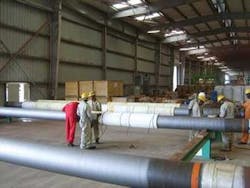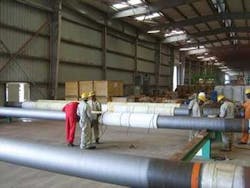Syntactic foam wrap helps protect casings against HP/HT damage
Nick Terdre - Contributing Editor
Trelleborg CRP has introduced CFW+, an upgraded version of its crushable foam wrap for use in high-pressure/high-temperature wells.
CFW mitigates casing failure caused by annular pressure-build-up, or trapped annular pressure, a phenomenon restricted to subsea wells. Fluids such as brine and drilling muds from the drilling phase, and solids such as rock chippings become trapped in the outer casing annuli, also known as the “B” and “C” annuli.
When the well is brought into production, and the hot wellstream flows to the surface, heat transfers to the outer annuli. This causes an increase in pressure in these annuli, which is not vented to air. The trapped fluids are incompressible so they do not mitigate pressure build-up.
If the pressure reaches a certain level, something has to give fluids may leak or, in the worst case, there may be catastrophic failure of the casing, says Guy Downie, manager of the subsea group at Trelleborg CRP. The well then has to be shut down, and may be lost permanently, leading to a large investment going down the drain these days a deepwater well into an HP/HT reservoir can cost $50-100 million. Recovery costs can be even more expensive.
There are well-documented cases, such as well A2 on BP’s Marlin deepwater development in the Gulf of Mexico. Much effort was put into investigating this incident. To quote from one resulting paper, “Pressurization of outer annuli due to the production of thermal effects was identified as one of two possible root causes of the failure” (SPE 77473).
Honeycomb structure
Trelleborg first launched CFW in the early 1990s as a means to combat annular pressure build-up when subsea wells were becoming increasingly popular as a means of production. Over the years, technology enhancement has expanded the operating envelope more than 4,000 psi (25.6 MPa) and 80-100º C (176-212º F). To date this has been sufficient to meet most requirements. Recent deliveries include a 21-well deepwater development off Nigeria.
But with downhole operating conditions becoming ever more extreme, the company decided a new grade of CFW with higher capabilities was needed. The result is CFW+, which can operate in temperatures of 175º C (347º F) or more and at much higher pressures.
CFW is a polymeric material with a honeycomb microstructure which collapses under pressure. It is made of syntactic foam resin with microscopic glass bubbles, or microspheres, embedded in it. Downie describes it as a mechanical fuse at a pre-determined pressure and temperature, the glass bubbles, which are voided, collapse, causing the material to shrink in size and allowing expansion of the annulus fluids and dissipation of potentially hazardous pressure.
For the CFW+ development, the resin system was modified to expand the operating envelope. Different grades of microspheres are used, with crush strengths ranging from 250 to beyond 18,000 psi (1.7 to beyond 124 MPa).
Each delivery is tailored to the requirements of the individual well as specified by the operator’s well design engineers. The amount of CFW is dictated by the collapse volume and crush percentage requirements, Downie says. The collapse volume is defined as the calculated volume increase of the annular fluids brought about by thermal expansion between the installation (or ambient) temperature and the operating temperature during production.
The crush percentage is defined as the amount of compression under isostatic load allowed by the foam before catastrophic collapse. This value is usually between 30% and 40% depending on the foam formulation. From the collapse value and the crush percentage, the total volume of foam required can be calculated. The crush mechanism is progressive over the pressure envelope, but complete failure is designed to occur well before the casing collapse pressure.
CFW typically is supplied in quadrant cylinders around 1 m (3.28 ft) long these are rectangular sections bonded to the outside of the production casing using an acrylic adhesive. They can be located anywhere within the annulus while still allowing the free flow of the liquids.
CFW is quick and easy to install on the casings onshore prior to deployment, whether by Trelleborg CRP off-site teams or by those installing the well.
There are other methods of mitigating annular pressure build-up, Downie says. For example, the wall casing can be dimensioned to withstand whatever pressure is anticipated in the outer annuli, implying a thick casing. Other options include insulated casing, to limit heat transfer, burst disks, or pumping nitrogen, a compressible fluid, into the outer annuli.
Currently, CFW is the only solution which operates on both pressure and temperature triggers, rather than pressure alone, according to Downie. “Additionally, the feedback we have received from our clients is that it is one of the few systems that works without affecting casing integrity.”
For more information, contact Guy Downie, Trelleborg CRP, Tel +44 1695 712 018, fax +44 1695 712 111.[email protected], www.trelleborg.com

